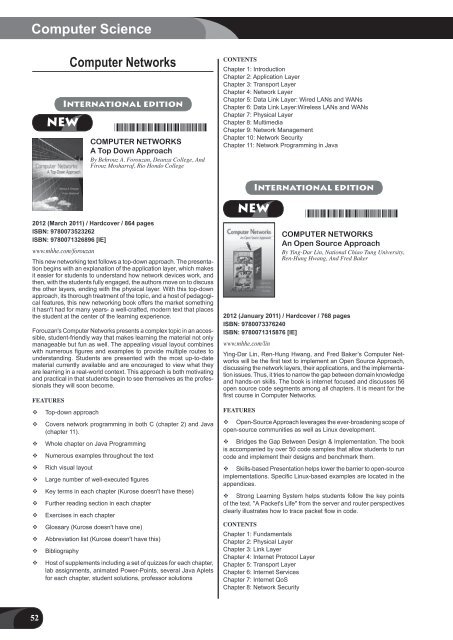Computer Science & Electrical Engineering 2012 - McGraw-Hill Books
Computer Science & Electrical Engineering 2012 - McGraw-Hill Books
Computer Science & Electrical Engineering 2012 - McGraw-Hill Books
You also want an ePaper? Increase the reach of your titles
YUMPU automatically turns print PDFs into web optimized ePapers that Google loves.
<strong>Computer</strong> <strong>Science</strong><br />
NEW<br />
<strong>Computer</strong> Networks<br />
International edition<br />
*9780073523262*<br />
COMPUTER NETWORKS<br />
A Top down Approach<br />
By Behrouz A. Forouzan, Deanza College, And<br />
Firouz Mosharraf, Rio Hondo College<br />
<strong>2012</strong> (March 2011) / Hardcover / 864 pages<br />
ISBn: 9780073523262<br />
ISBn: 9780071326896 [Ie]<br />
www.mhhe.com/forouzan<br />
This new networking text follows a top-down approach. The presentation<br />
begins with an explanation of the application layer, which makes<br />
it easier for students to understand how network devices work, and<br />
then, with the students fully engaged, the authors move on to discuss<br />
the other layers, ending with the physical layer. With this top-down<br />
approach, its thorough treatment of the topic, and a host of pedagogical<br />
features, this new networking book offers the market something<br />
it hasn't had for many years- a well-crafted, modern text that places<br />
the student at the center of the learning experience.<br />
Forouzan's <strong>Computer</strong> Networks presents a complex topic in an accessible,<br />
student-friendly way that makes learning the material not only<br />
manageable but fun as well. The appealing visual layout combines<br />
with numerous figures and examples to provide multiple routes to<br />
understanding. Students are presented with the most up-to-date<br />
material currently available and are encouraged to view what they<br />
are learning in a real-world context. This approach is both motivating<br />
and practical in that students begin to see themselves as the professionals<br />
they will soon become.<br />
Features<br />
52<br />
Top-down approach<br />
Covers network programming in both C (chapter 2) and Java<br />
(chapter 11).<br />
Whole chapter on Java Programming<br />
Numerous examples throughout the text<br />
Rich visual layout<br />
Large number of well-executed figures<br />
Key terms in each chapter (Kurose doesn't have these)<br />
Further reading section in each chapter<br />
Exercises in each chapter<br />
Glossary (Kurose doesn't have one)<br />
Abbreviation list (Kurose doesn't have this)<br />
Bibliography<br />
Host of supplements including a set of quizzes for each chapter,<br />
lab assignments, animated Power-Points, several Java Aplets<br />
for each chapter, student solutions, professor solutions<br />
52<br />
Contents<br />
Chapter 1: Introduction<br />
Chapter 2: Application Layer<br />
Chapter 3: Transport Layer<br />
Chapter 4: Network Layer<br />
Chapter 5: Data Link Layer: Wired LANs and WANs<br />
Chapter 6: Data Link Layer:Wireless LANs and WANs<br />
Chapter 7: Physical Layer<br />
Chapter 8: Multimedia<br />
Chapter 9: Network Management<br />
Chapter 10: Network Security<br />
Chapter 11: Network Programming in Java<br />
NEW<br />
International edition<br />
*9780073376240*<br />
COMPUTER NETWORKS<br />
An Open Source Approach<br />
By Ying-Dar Lin, National Chiao Tung University,<br />
Ren-Hung Hwang, And Fred Baker<br />
<strong>2012</strong> (January 2011) / Hardcover / 768 pages<br />
ISBn: 9780073376240<br />
ISBn: 9780071315876 [Ie]<br />
www.mhhe.com/lin<br />
Ying-Dar Lin, Ren-Hung Hwang, and Fred Baker’s <strong>Computer</strong> Networks<br />
will be the first text to implement an Open Source Approach,<br />
discussing the network layers, their applications, and the implementation<br />
issues. Thus, it tries to narrow the gap between domain knowledge<br />
and hands-on skills. The book is internet focused and discusses 56<br />
open source code segments among all chapters. It is meant for the<br />
first course in <strong>Computer</strong> Networks.<br />
Features<br />
Open-Source Approach leverages the ever-broadening scope of<br />
open-source communities as well as Linux development.<br />
Bridges the Gap Between Design & Implementation. The book<br />
is accompanied by over 50 code samples that allow students to run<br />
code and implement their designs and benchmark them.<br />
Skills-based Presentation helps lower the barrier to open-source<br />
implementations. Specific Linux-based examples are located in the<br />
appendices.<br />
Strong Learning System helps students follow the key points<br />
of the text. "A Packet's Life" from the server and router perspectives<br />
clearly illustrates how to trace packet flow in code.<br />
Contents<br />
Chapter 1: Fundamentals<br />
Chapter 2: Physical Layer<br />
Chapter 3: Link Layer<br />
Chapter 4: Internet Protocol Layer<br />
Chapter 5: Transport Layer<br />
Chapter 6: Internet Services<br />
Chapter 7: Internet QoS<br />
Chapter 8: Network Security

















